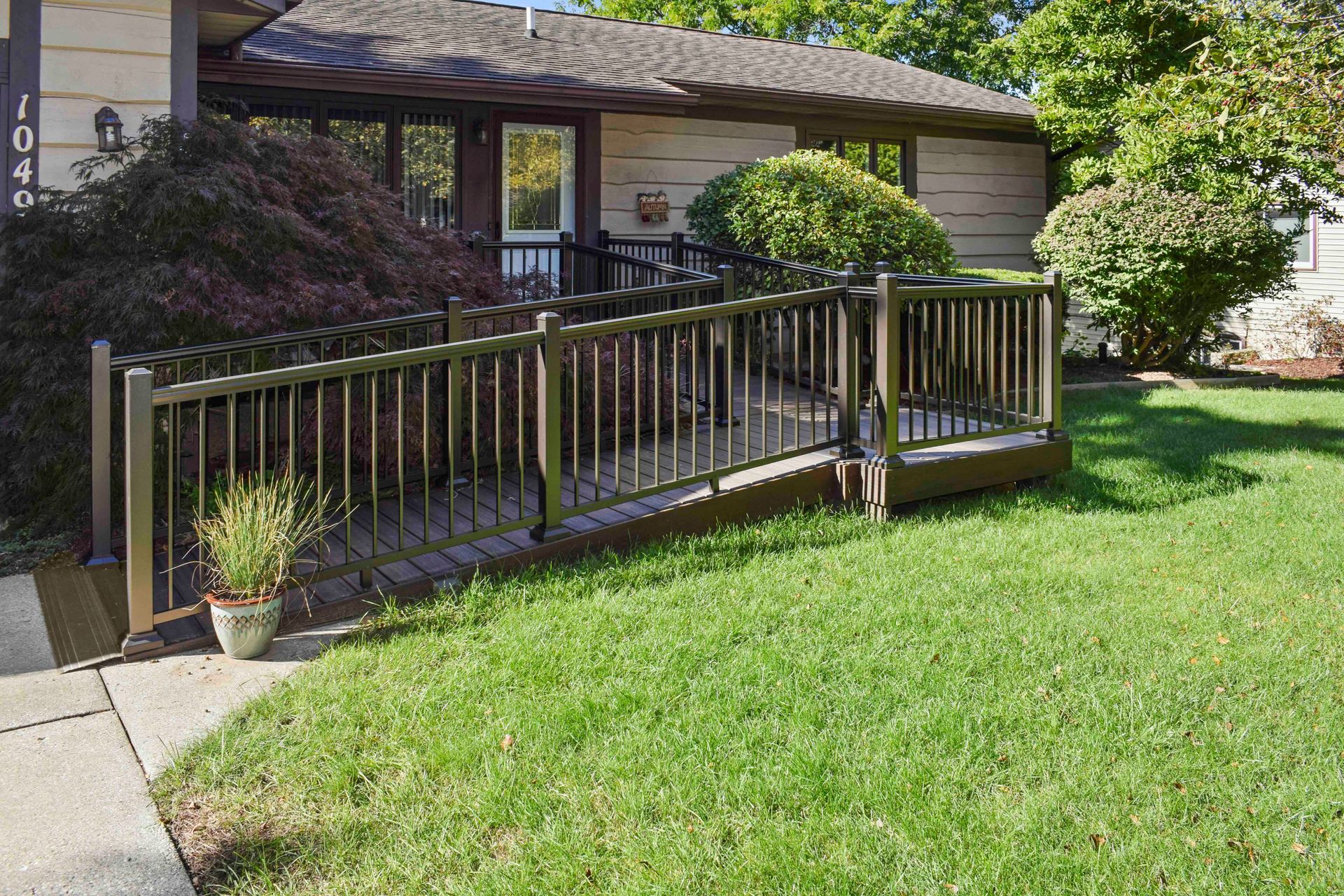What is Universal Design for Aging in Place?
Universal design is an innovative and inclusive way of making things and spaces work for everyone. It's like creating a world where age, abilities, and backgrounds don't limit what you can do or enjoy. This approach is like a superhero cape for design; it removes the need for extra adjustments or unique designs because it's built to include everyone from the start.
What is the Goal of Universal Design?
The main goal of universal design is to break down barriers and ensure everyone feels welcome and included. Imagine a world where age, height, health, or physical abilities don't stop anyone from fully participating in life.
That's what universal design is all about—creating spaces and things that fit the diverse needs of different people.
Whether you're a kid, a senior, tall, short, healthy, or facing health challenges, universal design has your back. It's like a friendly handshake to everyone, saying, "Come on in, you belong here!" It's not just about physical spaces; it's about ensuring everyone can dive into life's experiences without any roadblocks.
So, when architects and designers embrace universal design, they're like magicians who make spaces that feel good for everyone. It's like having a party where everyone can dance, regardless of age or abilities.
This way, no one feels left out, and everyone gets to enjoy the fun without worrying about fitting in or needing exceptional help.
Universal design is about making things and places like a good friend—always there for you, no matter who you are or what you need. It's a simple but powerful idea: "Let's design a world where everyone is included and no one is left behind."
Embracing Universal Design for the First Time
Embracing the principles of universal design unfolds a transformative narrative in residential architecture, culminating in homes that embrace diversity and stand as ideals of inclusivity and adaptability throughout the spectrum of human existence.
This ethos becomes particularly palpable in the realm of aging-in-place remodels, where the seamless integration of standard universal design features contributes to an environment that harmonizes with the evolving needs of its inhabitants.
No-Step Entry
A cardinal tenet of universal design is the establishment of a welcoming threshold, ensuring that entry into a home requires no steps. This design element goes beyond mere aesthetics; it is a fundamental shift toward universal accessibility.
By eliminating steps, individuals of all ages and abilities, including those using wheelchairs or mobility aids, can traverse the entryway effortlessly. This caters to the present needs of the occupants and future-proofs the home against potential mobility challenges that may arise.
One-Story Living
One-story living epitomizes the commitment to barrier-free environments by consolidating essential living spaces on a single level. This deliberate design choice is a testament to the foresight inherent in universal design, addressing the challenges posed by stairs and elevations.
Dining areas, bathrooms, and bedrooms seamlessly coalesce on a singular plane, ensuring that individuals of varying physical capabilities encounter a practical and accommodating home, fostering independence and longevity within familiar surroundings.
Wide Doorways
The installation of doorways spanning 32-36 inches in width represents a pivotal step in universal design. Beyond facilitating the unhindered passage of wheelchairs, these wider doorways promote an environment where the movement of people and objects is unrestricted.
This not only caters to the immediate needs of individuals with mobility aids but also acknowledges the practicalities of daily life, allowing for the smooth transition of furniture and other sizable items without encumbrance.
Wide Hallways
Universal design extends its reach into the very arteries of a home by advocating for hallways that are 36-42 inches wide. This deliberate spatial expansion is a strategic move toward enhancing mobility and ease of movement between rooms.
By accommodating a generous breadth, hallways become more than conduits; they become facilitators of an unimpeded flow within the living space. This design consideration embodies inclusivity, ensuring that every occupant navigates their home with ease and dignity, regardless of age or mobility.
Extra Floor Space
The allocation of additional floor space within the universal design framework transcends the practical and becomes a proclamation of respect for individual space and autonomy.
Beyond providing breathing room, this surplus space serves as a boon for individuals using wheelchairs, affording them the freedom to maneuver comfortably.
The intentional reduction of feelings of confinement reflects a nuanced understanding of the psychological impact of spatial design, contributing to a sense of well-being and overall satisfaction.
How Does Universal Design Support Aging in Place?
Universal design for homes is a forward-thinking approach that champions inclusivity, ensuring that living spaces are welcoming and accommodating for individuals of all ages and abilities.
This design philosophy becomes particularly significant when considering its benefits for aging in place, emphasizing the creation of environments that seamlessly adapt to the evolving needs of individuals over time.
One of the paramount advantages of incorporating universal design principles into homes is accessibility enhancement. By eliminating barriers such as steps at entrances, widening doorways, and creating one-story living spaces, homes become inherently more accessible for individuals with varying degrees of mobility. This fosters independence and caters to the needs of older adults who may face challenges related to stairs or narrow passages.
Additional Home Features That Support Universal Design and Aging in Place
These seemingly unassuming features within the realm of universal design possess a profound impact on the well-being and safety of home occupants. Each element, meticulously designed considering diverse needs, goes beyond mere functionality, playing a pivotal role in creating an environment that prioritizes safety and convenience.
Non-Slip Surfaces
Installing non-slip surfaces in flooring and bathtubs is not merely a practical choice but a strategic move toward fostering stability for every resident. It transcends its helpful purpose, emerging as a guardian against slips and falls, benefiting not only those who may be frail or face mobility challenges but also ensuring the safety of every individual traversing these surfaces.
Handrails and Grab Bars
Handrails and grab bars seamlessly integrate into the design narrative as subtle allies promoting stability within the household. Beyond aiding individuals with balance and support needs, they become silent sentinels, ensuring that every family member, regardless of age or ability, moves through spaces with an added layer of security and confidence.
Flush Thresholds
The insistence on flush thresholds represents a thoughtful consideration beyond wheelchair accessibility. While ensuring smooth and unobstructed passage for individuals with mobility aids, it concurrently addresses a universal concern—eliminating tripping hazards for everyone. This hidden design choice subtly contributes to a safer living environment where seamless transitions are integral to daily life.
Good Lighting
Implementing well-designed lighting solutions is not a mere commonplace consideration but an essential component that significantly impacts the overall safety and comfort of the living environment.
Beyond the immediate benefit for those with poor vision, it becomes a universal boon, enhancing visibility for everyone within the household. Adequate lighting transcends the function, creating an ambiance that is practical and conducive to well-being.
Lever Door Handles and Rocker Light Switches
Adopting user-friendly devices, such as lever door handles and rocker light switches, showcases a commitment to ergonomic design that resonates with the principles of universal accessibility.
While catering to the needs of individuals with diminished hand strength, these features go further by offering convenience to every household member. Their intuitive design seamlessly integrates into daily life, especially when hands are full, transforming mundane tasks into effortless interactions with the living space.
Universal Design Ideas
Consider Seamless Flooring
Prioritize the selection of smooth-surface, slip-resistant flooring to prevent slips and enhance accessibility for people needing walkers or wheelchairs. Low-pile carpeting can be employed in bedrooms and living spaces for added comfort and safety. Steer clear of throw rugs. These items pose a significant trip hazard. By making flooring choices that prioritize safety and ease of use, homes become more universally accessible and accommodating to various occupants.
Strategic Placement of Outlets and Switches
Attention to detail in the placement of light switches, thermostats, and other controls is paramount in universal design.
Position these controls no more than 48 inches from the floor, ensuring accessibility for standing and seated individuals. Optimal placement falls within the 36 to 48-inch range, accommodating the reach of most people. When controls are located above countertops, prioritize installing them closer to the countertop rather than higher above it.
Rocker-style light switches emerge as the most accessible choice due to their user-friendly on/off mechanism. Electrical outlets, crucial for various devices, should be positioned at least 15 inches from the floor, ensuring ease of access for everyone.
Make Sure Storage is Accessible
Storage, often a premium in homes, is pivotal in universal design. It should be ample, visible, and easily accessible without encroaching on floor space. Embrace built-in storage solutions, particularly in compact areas like bathrooms, to minimize clutter and maximize floor space.
Open shelving proves advantageous, especially for individuals with mobility devices, providing straightforward access to stored items. For closed storage, such as kitchen cabinets, prioritize D-shaped drawers and door pulls for ease of use. Implement full-extension glide drawers and pull-out storage solutions to reduce the need for bending and reaching.
Closets should feature adjustable shelving systems, ensuring adaptability to varying storage needs. A closet opening at least 32 inches wide and 5 feet of turnaround space in walk-in closets contribute to enhanced usability.
Select Durable Countertops and Vary Work Surface Heights
Incorporate thoughtful variations in countertop heights to cater to diverse users in kitchens, bathrooms, and laundry rooms. While standard countertops are typically 36 inches above the ground, integrating areas at 28 to 30 inches (such as a dining table) enhances accessibility for seated individuals and children.
Ensure that workstations, especially those around sinks, provide ample space for users to fit comfortably underneath the countertop. Considering lower workstations fosters inclusivity and accommodates a broader spectrum of users.
Opt for Appliances with Accessibility in Mind
Appliances are pivotal in daily life, and their placement significantly influences reachability. Position appliances at heights conducive to both standing and seated users, allowing for comfortable use by individuals in wheelchairs or with walkers.
Embrace under-the-counter models, such as microwaves or refrigerator drawers, in kitchen configurations to enhance accessibility. Create ample floor space in front of and to the side of appliances, facilitating smooth maneuverability for individuals with mobility aids.
Incorporating these universal design principles into homes results in environments that are not only accessible and inclusive but also adaptable to the changing needs of individuals over time, fostering a sense of belonging and independence for everyone in the home.
TALK TO THE EXPERTS OF LAKESHORE BARRIER FREE TODAY!
We believe that everyone should have access to every area of their home! We work directly with you to make sure that every grab bar, bathroom sink, kitchen countertop, patient lift, and more is at the perfect location for you and your loved ones. Call us at
(616) 477-2685 or email us at
Info@LakeshoreBarrierFree.com

CONTACT LBF for Barrier-free living
At Lakeshore Barrier Free, we strive to create welcoming, accessible, and functional living environments for everyone.

CONTACT LBF for Barrier-free living
At Lakeshore Barrier Free, we strive to create welcoming, accessible, and functional living environments for everyone.



Navigation
Services
All Rights Reserved | Lakeshore Barrier Free
Website by SPECK DESIGNS
All Rights Reserved | Lakeshore Barrier Free
Website by SPECK DESIGNS




